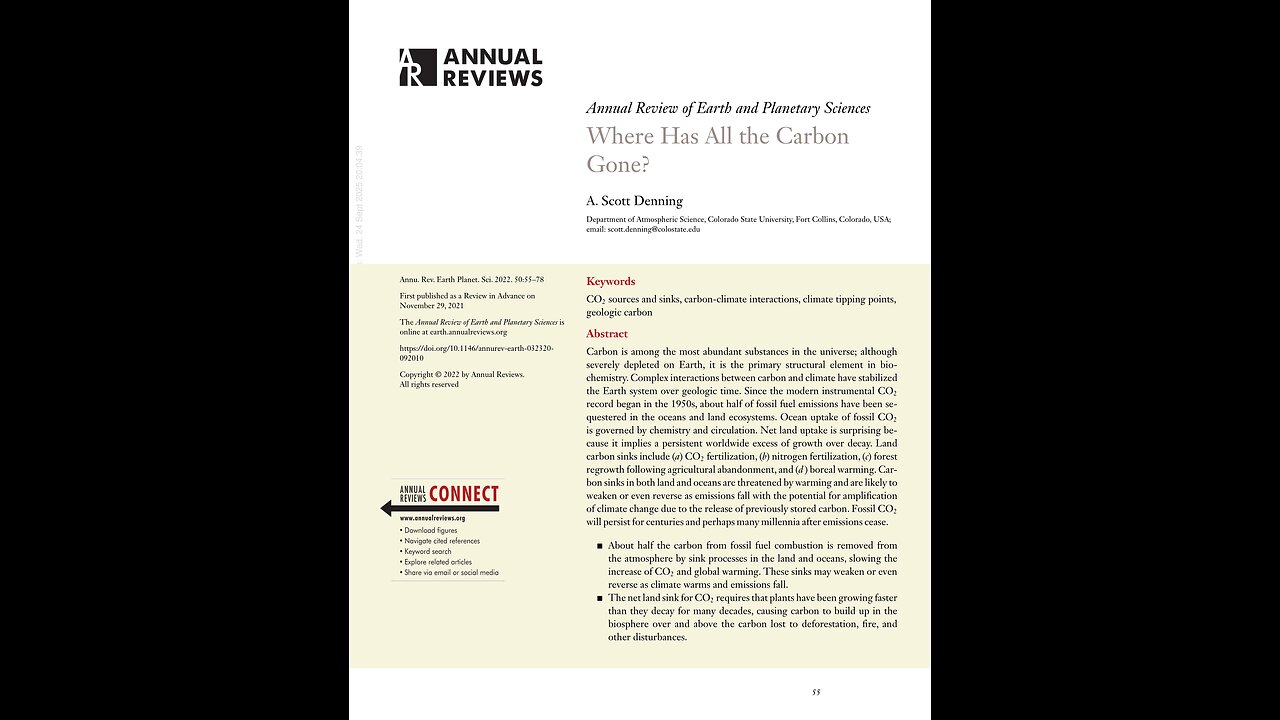Premium Only Content

Where Has All the Carbon Gone? November 29, 2021. A Puke(TM) Audiopaper
Index of Other Science Articles:
https://rumble.com/v3t4yzj-index-of-science.-music-by-dan-vasc.html
Annual Review of Earth and Planetary Sciences.
Where Has All the Carbon Gone?
Scott Denning.
November 29, 2021.
https://doi.org/10.1146/annurev-earth-032320-092010
Keywords: CO2 sources and sinks, carbon-climate interactions, climate tipping points, geologic carbon, global warming, climate change.
Abstract.
Carbon is among the most abundant substances in the universe; although severely depleted on Earth, it is the primary structural element in biochemistry. Complex interactions between carbon and climate have stabilized the Earth system over geologic time. Since the modern instrumental CO2 record began in the nineteen fifties, about half of fossil fuel emissions have been sequestered in the oceans and land ecosystems. Ocean uptake of fossil CO2 is governed by chemistry and circulation. Net land uptake is surprising because it implies a persistent worldwide excess of growth over decay. Land carbon sinks include:
(a) CO2 fertilization,
(b) Nitrogen fertilization,
(c) Forest regrowth following agricultural abandonment, and
(d) Boreal warming.
Carbon sinks in both land and oceans are threatened by warming and are likely to weaken or even reverse as emissions fall with the potential for amplification of climate change due to the release of previously stored carbon. Fossil CO2 will persist for centuries and perhaps many millennia after emissions cease.
About half the carbon from fossil fuel combustion is removed from the atmosphere by sink processes in the land and oceans, slowing the increase of CO2 and global warming. These sinks may weaken or even reverse as climate warms and emissions fall.
The net land sink for CO2 requires that plants have been growing faster than they decay for many decades, causing carbon to build up in the biosphere over and above the carbon lost to deforestation, fire, and other disturbances.
CO2 uptake by the oceans is slow because only the surface water is in chemical contact with the air. Cold water at depth is physically isolated by its density. Deep water mixes with the surface in about 1,000 years. The deep water does not know we are here yet!
After fossil fuel emissions cease, much of the extra CO2 will remain in the atmosphere for many centuries or even millennia. The lifetime of excess CO2 depends on total historical emissions, 10 percent to 40 percent could last until the year 40,000 A-D.
Where do we come from? What are we? Where are we going?
Paul Gaugin.
CO2: carbon dioxide; greenhouse gas. Primary product of both combustion and decomposition of organic matter; main source of plant carbon.
One. COSMIC AND PLANETARY CONTEXT.
Virtually all carbon is manufactured by stellar nucleosynthesis as a product of thermonuclear fusion of three helium nuclei in stars. After hydrogen and helium, carbon and oxygen, formed from four helium nuclei, are the most abundant elements in the universe, more common than all the other elements combined. Interstellar space is just filthy with the stuff, and the dark shadows of dense stardust are cold enough for complex chemistry to take place over cosmic time. Black tarry meteorites called carbonaceous chondrites are samples of the products of these interstellar reactions that can be analyzed in Earth-bound laboratories. They contain tens of thousands of organic compounds including sugars, lipids, and amino acids that form a superset of the basic building blocks of biochemistry.
During its formation, Earth was extremely depleted in cosmogenic carbon compounds due to intense radiation and frequent collisions in the inner Solar System. All life on Earth is based on chains, rings, tubes, and other complex nanostructures built from precursor molecules delivered to Earth through impacts from beyond the astronomical snowline.
Once the early Earth cooled below the boiling point of water, a global ocean condensed and acted as an efficient reaction vessel. Dissolved CO2 in water forms a weak acid, carbonic acid,
Caron Dioxide plus water reversibly reacts to form carbonic acid, equation one.
Which dissociates to form the bicarbonate ion and a proton, equation two.
A second dissociation produces carbonate ion, C O three, two minus, equation three.
At the pH and alkalinity of Earth’s oceans, about 90 percent of the dissolved carbon is in the form of bicarbonate ion and the net effect of adding CO2 is to consume a carbonate ion to produce bicarbonate.
Igneous rocks which are generically Calcium silicate dissolve in rainwater, dilute carbonic acid, to form sand and clay minerals, sediment, as well as bicarbonate and soluble cations, Calcium two plus, equation four.
Which are carried to the oceans and concentrated by evaporation to form salinity. Calcium in seawater reacts with carbonate ions to precipitate as calcium carbonate sediment (limestone),
Calcium and Carbonate Ions reversibly for Calcium Carbonate, equation five.
Some definitions.
Photosynthesis: biochemical conversion of oxidized inorganic CO2 into reduced organic biomass using solar energy; energy source of nearly all life.
Decomposition: biologically mediated conversion of reduced organic matter back to CO2; consumes oxygen and emits one-seventh of atmospheric CO2 annually.
Fossil fuels: coal, oil, and gas stored in sedimentary rocks by burial of dead organic matter over geologic time.
GtC: Giga-tons of carbon. Ten to the nine tons, equals ten to the twelve kilograms carbon. Each Giga-ton of carbon produces 3.67 Giga-tons of Carbon dioxide when burned with extra Oxygen mass.
Subduction of ocean crust into the upper mantle at plate boundaries melts marine sediments back into silicate magma and releases volatile CO2 to the atmosphere,
Calcium Carbonate plus silicate becomes calcium silicate plus carbon dioxide, equation six.
Which completes the geologic carbon cycle. For billions of years, the formation of calcium carbonate minerals by chemical precipitation dominated this geochemical removal process. About half a billion years ago the metabolic formation of structural body parts by marine biota became the dominant source of Calcium Carbonate, so almost all Phanerozoic limestone and dolomite is biologically precipitated.
On timescales longer than about 10 million years, the primary cycling of carbon in the Earth system is via plate tectonics. Volatilized CO2 is released from silicate magma through volcanic activity at plate margins and consumed through weathering of fresh mineral crystals exposed by uplift and erosion and removed from Earth’s atmosphere by the formation of carbonate minerals in the oceans. The rates of these reactions depend on mantle convection and are also strongly dependent on surface temperature and moisture. Together they form the primary negative climate feedback that has maintained Earth’s surface temperature between the freezing and boiling points of water for nearly the entire history of the planet even as the solar radiation has increased by about 30 percent.
Since its inception about 4 billion years ago, Earth’s metabolism has acted as a planetary-scale electrical circuit driven by a solar-powered reduction-oxidation battery. It is charged by photosynthesis, which splits water to provide both protons and free oxygen while generating copious amounts of chemically unstable reduced organic matter whose oxidation comprises the biospheric battery’s discharge. Carbon dioxide is a key reagent and organic matter in the energy storage medium. Electrons flow from the photosynthetic anode, conducted through living protoplasm and dead organic matter to be oxidized at the cathode of respiration. Carbon dioxide, free oxygen, and water, the most abundant chemicals in the universe, play the role of the electrolyte, equation seven.
N carbon dioxide plus n water reversibly forms C H two O, n plus n oxygen molecules.
The living carbon cycle has evolved to become incredibly vigorous. More than 40 percent of all atmospheric CO2 molecules now pass through plant stomata each year, and about 15 percent is consumed to form organic matter. This voracious carbon consumption would destroy all the CO2 in seven years except that decomposition regenerates it just as fast. Vigorous cycling of carbon through the biosphere has been in nearly perfect balance for billions of years, with less than a ten to the minus eight residual between CO2 production by the bioelectric anode and CO2 consumption by the bioelectric cathode. This tiny by-product accumulates over millions of years as sedimentary organic matter in Earth’s crust and as free oxygen in the atmosphere.
No more than a few carbon atoms per billion have escaped the metabolic and geologic churn to become trapped over the past half-billion years as rich organic deposits in crustal rocks that we call fossil fuels. In the past two centuries, people have mined this tiny residual for combustion to provide the primary energy supply for the global economy, leading to a dramatic rise in atmospheric CO2 to 420 parts per million by volume in 20 21. Over the past 30 years, CO2 has risen about 2 parts per million per year, 200 times as fast as the last great global warming and climate has warmed by about 0.6 Kelvin as a result. Continued combustion of fossil fuels until they are depleted would raise CO2 levels at least fivefold in a few centuries to levels not encountered in at least 100 million years.
Nearly all the carbon in the Earth system is locked up in the mantle in an extremely dilute form as carbon minerals, about one and a half billion GtC, Table 1, and most of the rest is in sedimentary limestone and dolomite in the crust. About 38,000 GtC is dissolved in the ocean, mostly in the form of bicarbonate ions.
Table 1. Carbon reservoirs on Earth.
The Columns are Reservoir, and Giga-tons of Carbon.
For example, the atmosphere has a reservoir of 850 Giga-tons of Carbon, and the surface oceans have a reservoir of 1,000 Giga-tons of Carbon.
Definitions.
CH4: methane; less abundant but stronger greenhouse gas than CO2, emitted during anaerobic decomposition.
14C: radiocarbon; unstable carbon isotope produced naturally by cosmic rays and by nuclear weapons testing; radioactive half-life of about 5,730 years.
Fossil fuel deposits (coal, oil, and gas) contain about 10,000 GtC. The terrestrial reservoir is dominated by soil organic matter (about 2,000 GtC) and permafrost (about 1,000 GtC). Living vegetation contains about 500 GtC. The atmosphere currently contains about 850 GtC, and this reservoir is increasing by about 5 Giga-tons of Carbon per year due to combustion of fossil fuels.
Two. HISTORICAL PERSPECTIVE.
2 point 1. Early Work.
The book the Discovery of Global Warming by Weart published in two thousand and eight provides a wonderful historical perspective on the related concepts of planetary energy balance, carbon dioxide, and global warming before the development of instruments for precise measurement of CO2 in air in the mid nineteen fifties. Archer and Pierrehumbert in 20 11 have gathered and republished some of the most important historical papers on this topic. Fourier first identified in 18 24 the role of the atmosphere in sustaining Earth’s climate by absorbing and reradiating outgoing infrared energy. He coined the greenhouse analogy to explain this effect. Eunice Foote performed experiments in 18 56 with various gases exposed to sunlight and identified CO2 as an important greenhouse gas. A few years later, John Tyndall published a series of studies documenting the dependence of infrared absorption on the concentrations of CO2, water vapor, and methane (CH4) in air. He speculated that continued burning of coal might lead to sufficiently elevated concentrations of CO2 to warm Earth’s climate.
In the early twentieth century, it was widely expected that enhancements of CO2 from burning coal would be mitigated by the solubility of the gas to form carbonic acid in the oceans. Indeed, early analytical methods for quantifying atmospheric CO2 were based on bubbling air through water in the laboratory and measuring the change in pH due to dissociation of carbonic acid. Guy Callendar suspected that increasing industrial coal combustion was increasing CO2 and conducted a series of measurement campaigns in the nineteen thirties to test this hypothesis.
These data were not sufficiently precise to establish an increasing trend with much confidence but appeared to show rising concentrations.
2 point 2. Advent of the Modern CO2 Record.
Carbon has three natural isotopes: Carbon 12, 13, and 14. Carbon 12 is by far the most abundant: About 99 percent of all carbon is Carbon 12, and almost all the rest is Carbon 13. Plant carbon is slightly enriched in Carbon 12 relative to Carbon 13 because the lighter isotope diffuses a little faster into plant stomates and is more easily assimilated by the biochemistry of photosynthesis.
Fossil fuels are derived from plants (primarily marine algae), so the stable carbon isotope ratio of both the fuels and the carbon in combustion-derived CO2 reflects the lighter composition of plants. Carbon 14 (radiocarbon) is produced by cosmic ray bombardment of nitrogen in the stratosphere. It is radioactive with a half-life of about 5,730 years. Fossil fuels are typically hundreds of millions of years old, thousands of times longer than the radioactive decay time of Carbon 14, so burning fossil fuels produces CO2 with no measurable radiocarbon. Revelle and Suess in 19 57 documented the atmospheric dilution of both Carbon 14 dioxide and Carbon 13 dioxide by plant-based fossil fuels and realized that these subtle but measurable changes in the isotopic composition of airborne CO2 could be used to estimate the fraction of fossil CO2 remaining in the atmosphere.
Charles David Keeling developed a nondispersive infrared gas analyzer in the nineteen fifties that allowed the first measurements of CO2 with sufficient precision to detect seasonal and geographic patterns. He began systematic monitoring of background CO2 at La Jolla, California, in 19 57 and then at the South Pole and the top of Mauna Loa in Hawaii in 19 57 and 19 58.
These measurements led to a revolution in scientific understanding of the carbon cycle, climate, and (eventually) sustainability of the global system of energy and economics.
Within just a few years, Keeling’s measurements of CO2 in background air had established the broad outlines of the global carbon cycle. Repeating seasonal cycles in the Northern Hemisphere reflect the drawdown of CO2 by photosynthesis during the spring and summer and its subsequent replacement by organic decomposition during the autumn and winter. A slow but steady secular trend of rising concentrations shows that contrary to expectations 50 years before, dissolution of carbonic acid in the oceans was insufficient to offset emissions due to carbon combustion. Persistent spatial gradients in the measured concentration and seasonal cycle of CO2 between Hawaii and the South Pole demonstrated both the predominance of combustion in the Northern Hemisphere and the roughly 1-year timescale of interhemispheric transport by the atmosphere.
Bolin and Bischof estimated in 19 70 that only about one-third of the CO2 released as industrial emissions remained in the atmosphere, with about half of the emissions being absorbed by the oceans, and the remainder being sequestered in the terrestrial biosphere because of what they called a CO2 fertilization effect. They noted that their estimates suggested very rapid transfer of CO2 across the surface of the ocean, and that the slow rate of transfer between the surface layers and deeper ocean represents the most significant barrier to carbon storage. The question of the rate of carbon penetration into the deep ocean was investigated by Oeschger et al in 19 75, who developed a 1D box-diffusion model of the world ocean. In contrast to previous models, they did not treat the deep ocean as a single, well-mixed box, but rather as a series of boxes through which the penetration of CO2 was determined by eddy diffusion. Their model was calibrated by the observed profiles of natural radiocarbon and verified using observed penetration of Carbon 14 produced during the atmospheric nuclear weapons tests. Their results supported a somewhat more efficient oceanic uptake than in previous studies, but they still argued for a small sink of atmospheric carbon in the terrestrial biosphere to balance the global budget.
2 point 3. Ecologists Versus Oceanographers: The Missing Sink Controversy.
The disparity between production inventories of fossil fuel and measurements of anthropogenic carbon in the atmosphere in the ocean in the nineteen seventies required a substantial net carbon sink on land.
Many terrestrial ecologists rejected the implication that the rate of plant production and storage of biogenic carbon on land exceeded the rate of carbon loss through deforestation and other land use change. Reconciling observed changes in CO2 with documented carbon losses from forests and soils led to the concept of a missing sink required to balance sources.
2 point 3 point 1. Global carbon budget.
The concept of the global carbon budget that had emerged by the mid nineteen seventies was one in which fossil fuel emissions of CO2 to the atmosphere were about halfway compensated for by absorption into the oceans, with a small amount of carbon also being sequestered in the terrestrial biosphere. This concept was challenged by Bolin in 19 77. He proposed that rather than being a sink for anthropogenic carbon, the biosphere was actually losing carbon at a rate comparable to the burning of fossil fuels as forests were cut and natural ecosystems were converted to agricultural production. There was a lively controversy that dominated the carbon cycle literature for the next decade. Broecker et al in 19 79 refuted Bolin’s proposed biospheric carbon loss by analyzing the uncertainty of model estimates of oceanic uptake. They concluded that the estimates were sufficiently firm that large emissions of CO2 from the biosphere could not be accounted for in either the atmosphere or the ocean.
The great majority of the labile carbon in the Earth system is dissolved as ions in seawater, see Section 1, but only a tiny fraction of the marine reservoir of dissolved inorganic carbon interacts with the atmosphere on decadal timescales. The mean depth of the oceans is about 4,000 meters, but only 50 to 200 meters are in physical contact with the atmosphere because of strong thermal stratification below the warm surface in the thermocline. Carbon dioxide dissolves in surface water according to the equilibria discussed in Section 1, and its solubility is about twice as great in cold polar waters as it is in warm tropical waters. During winter at the highest latitudes, surface water becomes cold enough to sink into the deep ocean, and the rest of the deep water is derived from this very cold polar water.
In 19 83 Siegenthaler developed a modified model of oceanic carbon uptake, based on the work of Oeschger et al from 19 75, but including faster penetration into a high-latitude outcrop of cold thermocline waters. Ventilation of the thermocline allows faster penetration of CO2 into the deep ocean because of the enhanced solubility at low temperatures and because transport is rapid along constant-density surfaces. Even the faster uptake of anthropogenic CO2 by this new outcropdiffusion model could not account for the large biospheric releases proposed by the ecologists, however. The missing sink controversy between the ecologists and geochemists was summarized by Hobbie et al in 19 84.
In the mid nineteen eighties, CO2 concentrations were determined for ancient air trapped in Antarctic ice cores. The ice core data could be directly compared with the concentrations predicted by the ecological reconstructions. Siegenthaler and Oeschger in 19 87 used box-diffusion and outcrop-diffusion models of ocean uptake to reconstruct the past 200 years of emissions of CO2 from the biosphere by deconvolution of the ice core CO2 record. Ocean uptake as predicted by the ocean model was subtracted from the observed time series of CO2 concentration in the ice core data, resulting in independent estimates of biospheric release. They concluded that although significant biospheric carbon loss had indeed taken place during the nineteenth and early twentieth centuries, the global biosphere was by the nineteen eighties either a very small source or even a net sink for atmospheric CO2.
2 point 3 point 2. Atmospheric transport inverse modeling.
Easily available, frequent measurements of CO2 around the world and improvements in atmospheric transport models during the nineteen eighties allowed the carbon budget to be studied by an inverse approach in which observations were combined with simulated transport to deduce surface sources and sinks of CO2. Using a 3D transport model derived from observed wind fields, a group led by Charles David Keeling and Martin Heimann deduced features of the global carbon cycle from observations of concentration and stable isotopic composition of background samples of CO2 from 10 stations spanning the north-south extent of the Pacific over more than 30 years. They found that:
(a) The annual cycle of CO2 is driven almost entirely by seasonal decoupling between photosynthesis and decomposition in the Northern Hemisphere.
(b) Carbon sinks in both the ocean and land account for about half of fossil fuel emissions and
(c) A small excess of global photosynthesis relative to decomposition dominates the release of carbon by land clearing and deforestation, primarily in the tropics by the nineteen eighties.
Definition.
Fixed nitrogen: reactive nitrogen species available for biosynthesis; atmospheric N2 is not fixed because its double bond is too strong.
Tans et al in 19 90 combined atmospheric concentration data at dozens of remote stations and 3D tracer transport modeling with millions of measurements of the partial pressure of dissolved CO2 at the sea surface to further constrain the spatial patterns of carbon sinks. They found that at least half of the uptake of fossil CO2 occurs in the Northern Hemisphere where the area of ocean basins and the density of sea-surface partial pressure of carbon dioxide data rule out air-sea gas exchange as the primary mechanism. They concluded that about one-fourth of fossil CO2 is absorbed on land, primarily in the Northern Hemisphere, and another one-fourth by oceans, primarily in the Southern Hemisphere.
Trends in multiple carbon trace gases revealed more detail about carbon sources and sinks. Stable isotopes in CO2 helped to further distinguish between land and ocean carbon uptake. The ratio of oxygen 18 to oxygen 16 in CO2 carries the signature of the last water in which the CO2 was dissolved, and observations of this ratio were used by Ciais et al in 19 97 to estimate the rate of gross photosynthesis and CO2 exchange with vegetation. Combustion, photosynthesis, and decomposition have unique stoichiometric ratios of carbon and oxygen exchange, whereas air-sea gas exchange of CO2 has almost no effect on oxygen. Rayner et al in 19 99 and Battle et al in two thousand combined observations of these tracers to document temporally resolved changes in both land and ocean CO2 sinks.
2 point 4. Mechanisms Responsible for a Land Carbon Sink.
Even though plants eat CO2 for a living, it is surprising that land ecosystems accumulate carbon at planetary scale. Photosynthetic carbon is released to the atmosphere by decomposition, the respiration of microbial organisms, and fire at a rate that is proportional to the amount of dead organic matter. Sustained carbon uptake on land requires a long-term excess of photosynthesis over decomposition such that carbon accumulates in living and dead organic matter. Because the rate of CO2 release scales with stored organic matter, this implies that global photosynthesis must continue to increase over time. At least four major processes have been invoked in attempts to explain this unexpected result:
(a) CO2 fertilization,
(b) Enhanced nutrient availability,
(c) Recovery of forests from previous disturbances, and
(d) The response of boreal and Arctic ecosystems to rapid warming.
Plant physiologists have long known that many plants grow more vigorously in air with elevated concentrations of CO2, especially in environments with ample nutrients and water.
The simplest hypothetical mechanism for a persistent increase in the rate of global photosynthesis is that it is simply driven by rising concentrations of CO2. Chemical uptake of CO2 in chloroplasts increases with CO2 concentration, so global photosynthesis should increase with rising CO2. As long as the rate of increase of atmospheric CO2 is rapid compared to the turnover time of carbon in the land biosphere, increases in gross primary productivity (GPP) could stay a decade or two ahead of increases in decomposition.
The trouble with the CO2 fertilization mechanism of land carbon is that most land ecosystems are not CO2 limited. Other critical resources include light, water, substrate, and chemical nutrients such as nitrogen and phosphorus. Experiments in greenhouses, where growing conditions are ideal, typically find much larger growth enhancement due to elevated CO2 than in research conducted outdoors using Free Air CO2 Enrichment, FACE. The productivity of most natural terrestrial ecosystems is most often limited by fixed nitrogen, meaning that additions of nitrogen lead to increased growth.
Oren et al conducted multifactorial outdoor FACE experiments in two thousand and one in forest plots in which water, temperature, and nitrogen were varied over a period of decades as well as CO2. They concluded that elevated CO2 produced a burst of enhanced growth for just a few years until available nitrogen was depleted in soils and litter. After this initial bump, forest growth under high CO2 was indistinguishable from control plots, but growth was enhanced in the high CO2 plots again if additional nitrogen was added.
As it turns out, humans are adding fixed nitrogen to ecosystems as well as CO2. Atmospheric nitrogen is almost completely unusable to plants because of the very strong triple bond in the N2 molecule. Prior to the industrial revolution, nearly all biological productivity was supported by nitrogen-fixing microbes or lightning, which can break the N2 bond and release reactive nitrogen to serve as the limiting ingredient for amino acid and protein synthesis.
The Haber-Bosch process developed in the early twentieth century allowed the production of fixed nitrogen from air using artificial heat and pressure, leading to the unprecedented increases in agricultural production that facilitated the human population explosion. Combustion at high temperatures and pressures, for example in factories and engines, also burns air to create fixed nitrogen in the form of Nitric Oxide and Nitrogen Dioxide. Both agricultural fertilizer and nitrogen oxides are carried downwind and downstream, meeting nitrogen demand in ecosystems that are already fertilized by enhanced CO2. This cofertilization by CO2 and nitrogen may account for much of the terrestrial carbon sink, especially in forests where carbon to nitrogen ratios more than 200 are common.
The concept of succession in ecology suggests that entire ecosystems, including the plant community, soil organic matter, and the microorganisms that decompose it, evolve toward an equilibrium state in which net ecosystem production approaches zero as time passes after a disturbance such as fire or harvest. Major disturbances such as fires and logging release carbon into the atmosphere but are followed by a period of recovery during which time growth far outstrips decomposition. In many regions of the northern temperate zone, changes in agroeconomics have led to reversion of agricultural lands to forest. As secondary forests age, they accumulate carbon. Although clearing of temperate forests for farmland was the primary source of rising CO2 in the nineteenth century, systematic repeated inventories of wood showed that many forests probably switched to a carbon sink a century later, especially as rates of regrowth were enhanced by CO2 and nitrogen deposition. The warming climate has accelerated the release of nutrients through decomposition and extended the growing season in temperate forests, leading to enhanced carbon storage.
In boreal and Arctic regions, the warming climate also contributes to the land carbon sink. Productivity in very cold climates is limited by the short growing season and by the very slow decomposition of nutrient-rich organic matter in litter and soil.
The Arctic is warming between two and three times as fast as the global mean, and in some regions the frost-free season is 50 percent longer than it was just a few decades ago. By the mid nineteen nineties, remote sensing based on the spectral reflectance of plant leaves since 1979 showed significant regional greening across most high-latitude regions.
Three. MEASUREMENT, MONITORING, AND ANALYSIS.
Understanding where all the carbon has gone requires watching carefully where it comes from and how it gets where it is going. Monitoring the contemporary global carbon cycle involves comprehensive interdisciplinary efforts to collect and analyze data on land, in the oceans and atmosphere, and from orbiting satellite instruments. National and international programs have been organized for coordinating and updating data collection, analysis, and synthesis.
Definitions.
Delta Carbon 13: fractional difference in the stable isotope ratio 13 C to 12 C from a laboratory standard, expressed in parts per thousand, per mil.
Delta Oxygen 18: fractional difference in the stable isotope ratio 18 O to 16 O from a laboratory standard, expressed in parts per thousand, per mil.
COS: carbonyl sulfide. Trace carbon gas emitted primarily in the oceans and consumed by vegetation; used as a tracer of photosynthesis.
These monitoring programs are important for ongoing efforts to test mechanistic hypotheses about the evolving carbon cycle and to develop predictive models of the future of carbon and climate on Earth.
3 point 1. Land.
Traditional land inventories intended for economic interests, forestry, agriculture, have been repurposed for carbon accounting, but harmonizing methods and data quality across dozens of separate national entities is difficult. Comprehensive analyses that seek to integrate national data to planetary scale are important constraints on land carbon stocks and sinks.
Global data on fossil fuel emissions are compiled as national inventories and have been synthesized into global data sets maintained by the Carbon Dioxide Information and Analysis Center. Realistic space and time variations combine national inventory data with actual locations of power plants and other point sources, satellite measurements of the intensity of artificial lighting at night, weather, and economic information.
Eddy covariance is a statistical technique for quantifying exchanges of energy, water, carbon, and trace gases over scales of hundreds of meters from measurements of turbulent variations of vertical velocity and atmospheric quantities at very high frequency, typically 10 to 20 times per second. By the two thousands, hundreds of these experiments were being conducted across dozens of countries all over the world, and harmonized data have been compiled and synthesized for global research.
3 point 2. Ocean.
Millions of samples of surface ocean water have been collected and analyzed for dissolved carbon species. Taro Takahashi and his colleagues spent a lifetime interpolating and synthesizing these measurements using information about temperature, salinity, and ocean currents to create global maps of air-sea CO2 exchange. In recent decades research sampling has been augmented by in situ measurements by instruments aboard commercial vessels. During the nineteen nineties and two thousands, a massive international program, the Joint Global Ocean Flux Study, was undertaken to collect samples of the 3D volume of the ocean and analyze deep water for a suite of biogeochemical constituents. Combining deep and surface data in ocean transport models provides a comprehensive window into the biogeochemical sequestration of anthropogenic carbon.
3 point 3. Atmosphere.
The atmosphere provides a global mixing medium and serves as the final integrator of all surface carbon exchanges. Concentrations of CO2 have been tracked continuously since 19 57, and a full suite of carbon gases and their stable isotopes is tracked weekly at remote sites around the world via flask sampling for analysis at central laboratories. Stable isotopes fractional Carbon thirteen and fractional Oxygen eighteen in CO2 contain information about ocean versus land sinks and changes in photosynthesis versus decomposition. Carbonyl sulfide (C O S) is a sulfur analog of CO2 that is taken up in plant leaves by carbonic anhydrase. Carbonyl sulfide has been used to trace gross photosynthesis because, whereas plant-assimilated CO2 is eventually returned to the atmosphere by respiration, the hydrolysis of Carbonyl sulfide in plant tissues is irreversible. Since two thousand, accurate and precise in situ instrumentation for CO2 has been deployed at towers in continental regions as well. Vertical sampling by aircraft with flask samplers and in situ instrumentation has been used for both research campaigns and long-term characterization of carbon gas variations in the free troposphere.
Definition.
ESM: Earth system model. Numerical simulation of coupled Earth systems including physical climate, hydrology, biology, and the carbon cycle.
Several research groups around the world use atmospheric tracer transport models to produce optimized maps of time-varying CO2 exchange at regional scale by inversion of concentration measurements from various observational systems.
3 point 4. Satellites.
Space-based observations provide a truly global perspective and are not limited by territorial access restrictions but are extremely expensive to collect. Satellite-based remote sensing of the physiological status of global land vegetation has been continuous since 19 79 and has matured tremendously over a period of decades as instruments and analytical techniques improved. Optical spectroscopy provides kilometer-scale information about vegetation type, leaf area, and productivity on seasonal and inter-annual timescales. Microwave radiometry and active sensors, radar and lidar, help quantify drought stress, tree height, and biomass. Biomass burning is detected in real time from thermal infrared imagery, and burned area is routinely mapped using optical spectroscopy. Solar induced chlorophyll fluorescence by plants is used to map variations in photosynthesis. Ocean color provides time-resolved mapping of chlorophyll and other phytoplankton properties, which can be analyzed to estimate biological productivity. The solubility of CO2 depends on sea-surface temperature and salinity, and air-sea gas exchange depends on wind speed. These physical variables are characterized using combinations of infrared and microwave observations.
Since two thousand and nine, the atmospheric column-mean CO2 mole fraction has been estimated using nearinfrared spectroscopy. Calibration of these retrievals against laboratory data is critical because variations in a column of less than 0.3 percent, 1 part per million by volume on a background of 420 parts per million on volume, contain the relevant science information, so a network of Fourier transform infrared solar spectrometers has been deployed to link orbital and laboratory calibrations. Limb sounders use solar occultation by the atmosphere to retrieve concentrations of Carbonyl sulfide, which constrains large-scale carbon uptake by photosynthesis.
3 point 5. Modeling and Synthesis.
A series of intensive regional experiments has been used to develop and test comprehensive carbon cycle models constrained by observations.
Consistent analytical approaches have been developed to use global data in biogeochemical models. Land carbon models were developed that link the biochemistry of photosynthesis with stomatal physiology, carbon allocation, storage, and turnover in organic matter pools. Dynamic global vegetation models and simulations of ecosystem demography and succession simulate the replacement of plant assemblages as climate and land use evolve. Comprehensive models of land, atmosphere, and ocean carbon exchange are now coupled with the entire climate system via Earth system models, ESM’s, used to investigate and project global change. All aspects of the carbon cycle are analyzed and updated in annual synthesis reports by an international collaboration, the Global Carbon Project, Figure 1.
Figure 1.
Combined components of the global carbon budget illustrated as a function of time, for fossil CO2 emissions (gray) and from land-use change (brown), as well as their partitioning among the atmosphere (blue), ocean (turquoise), and land (green). Abbreviation: GtC, Giga-tons of carbon.
Four. CARBON-CLIMATE FEEDBACK, TIPPING POINTS, AND THE FUTURE.
4 point 1. Carbon-Climate Feedback.
The Earth system is complex, and both climate and the carbon cycle experience a range of positive and negative feedback effects that can be analyzed following engineering and control theory. In climate science the atmospheric CO2 concentration is typically considered to be a forcing, proximate cause of changes in temperature, on timescales up to centuries, equation eight:
Delta T equals alpha times the log of the CO2 ratio, divided by the log of two.
Where delta T is the change in global mean surface air temperature (Kelvin), CO2 is the current mole fraction in air (parts per million by volume), CO2, zero refers to an initial time at which delta T equals zero, and alpha is the sensitivity of temperature to CO2, in Kelvin per doubling of CO2. Note the logarithmic relationship.
Definitions.
C4MIP: Coupled Climate Carbon Cycle Model Inter-comparison Project, simulation experiments investigating interactions of carbon and climate with each other.
IPCC: Intergovernmental Panel on Climate Change, international reporting body charged by the United Nations to assess climate change.
Hundreds of studies have estimated alpha in Equation 8 based on observations, theory, and paleoclimate data, with a mean of about 3 plus or minus 1.5 degrees Celsius per doubling of CO2.
On timescales of seasons to decades, changes in atmospheric CO2 are determined by emissions and changes in the reservoirs of carbon stored on land and in the oceans, equation nine gives:
Delta C sub “A” equals E plus delta C sub L plus Delta C sub O
Where E is anthropogenic CO2 emissions and delta C sub “A”, delta C sub L, and delta C sub O are the annual change in the mass of carbon stored in the atmosphere, land, and ocean, all in Giga-tons of carbon per year.
For the purposes of feedback analysis, changes in the land and ocean carbon reservoirs are expressed as equations ten and eleven in the text.
Delta C sub L, equals beta sub L times delta C sub A, plus gamma sub L times delta T, and:
Delta C sub O, equals beta sub O times delta C sub A, plus gamma sub O times delta T.
where beta sub L and beta sub O are the sensitivity of land and ocean carbon storage to changes in atmospheric CO2 and gamma sub L and gamma sub O, units of Giga tons Carbon per Kelvin, are the sensitivity of carbon storage to temperature.
The system of equation ten and eleven are a two by two matrix equation.
As discussed in Sections 2 and 3, rising atmospheric CO2 can lead to strong sinks on land due to CO2 fertilization and in the oceans due to solubility and changes in circulation. These are negative feedback processes beta sub L and beta sub O less than zero in Equation 10, because rising CO2 is opposed by surface uptake of some of the excess. On the other hand, warming is expected to lead to positive climate carbon feedback, gamma sub L and gamma sub O in Equation 11. Rising temperatures may weaken or reverse carbon sinks on land due to warmer soils and to temperature or drought stress on vegetation. Warmer ocean temperature decreases CO2 solubility at the surface and increases thermal stratification of the water column, which in turn decreases nutrient supply and transport of carbon to deep waters.
In practice, the feedback factors in equations ten and eleven have been estimated using coupled ESM’s from simulation experiments in which radiative and biogeochemical effects of CO2 on temperature and land-ocean-atmosphere exchange are isolated by enabling and disabling model components. These experiments have been conducted with a large suite of models as part of the Coupled Climate Carbon Cycle Model Inter-comparison Project, C4MIP.
These simulations are fundamentally different from traditional climate projections in that atmospheric CO2 is predicted rather than prescribed. Instead, fossil fuel emissions are prescribed, using a high emission scenario, ocean and land sinks are calculated, and atmospheric CO2 is deduced on the model time step using logic like that in Equations 9 to 11.
Simulated vegetation and soils in C4MIP respond to changes in temperature, moisture, and CO2. Some but not all of the ESM’s include dynamic global vegetation, which replaces current ecosystems with other types of vegetation, conversion of forests to pastures, grasslands, or savannas, in response to climate change. Simulated ocean carbon responds to temperature-dependent air-sea gas exchange and solubility, marine biology and biogeochemistry, and circulation. Temperatures then respond according to Equation 8, and the simulation continues. These experiments are integrated from 18 50, representing preindustrial conditions, to twenty one hundred.
Carbon-climate feedbacks have been analyzed using the C4MIP protocol and assessed by the Intergovernmental Panel on Climate Change (IPCC) ever since.
The first C4MIP simulations produced a shocking range of variation in future behavior of the coupled carbon-climate system. Ocean uptake in the late twenty-first century varied by a factor of two among models, from about 3.5 Giga-tons of Carbon per year to about 10 Giga-tons of Carbon per year compared to a contemporary value of about 2 Giga-tons of Carbon per year. Changes in the land carbon cycle were even more variable. The land component of many ESMs accumulated vast amounts of carbon as atmospheric CO2 rose, with little or no limitation from nutrients. Models that included nutrient limitation absorbed much less CO2 in the twenty-first century. Some models developed severe physiological stress due to heat and drought arising from high CO2, with at least one model converting the Amazon rainforest to savanna and releasing hundreds of Giga-tons of Carbon to the atmosphere. Land carbon balance at the end of the twenty-first century in this first set of C4MIP experiments ranged from a sink of 11 Giga-tons of Carbon per year to a source of 6 Giga-tons of Carbon per year. As a result of the huge model spread in simulated carbon-climate feedback, atmospheric CO2 in 2100 differed by about 300 ppmv and the spread of biogeochemical feedback was among the biggest sources of uncertainty in future climate, even though the experiment held fossil fuel emissions constant.
Gregory et al in 20 11 analyzed carbon cycle feedbacks to climate in the context of physical climate feedback. They found that the future behavior of the carbon cycle is in fact the dominant source of uncertainty in overall climate feedback and sensitivity, less constrained than even cloud and aerosol processes, which have received far more attention in the climate change literature. Partly in response to the huge range of simulated carbon-climate responses in the C4MIP experiments, the next generation of carbon cycle treatment in ESMs included additional mechanisms and detail. The additional detail among models reflected maturing science but led to even greater variance among C4MIP simulations reported in the IPCC Fifth Assessment.
There are some serious limitations to this analytical framework for carbon-climate feedback.
Linearization of such a complex system of interactions can be considered valid only for small perturbations delta Carbon dioxide, delta Temperature, delta C sub L, and delta C sub O. Even the historical record includes delta carbon dioxide over carbon dioxide of about 50 percent relative to preindustrial conditions, and projecting feedback derived from historical changes into the future requires assuming the linear sensitivities to be invariant over very large changes in the state of both climate and carbon processes. Worse, the behavior of sources and sinks in the land and ocean is assumed to be directly proportional to changes in atmospheric CO2. As we have seen in Sections 2 and 3, land sinks almost certainly result from a combination of mechanisms, most of which do not scale with CO2, for example nutrient deposition, changes in land use and land management, and longer growing seasons. Assuming that the land sink is proportional to rising CO2 risks systematic overestimation if the past sink was responding to transient processes that are independent of CO2 concentration that may well disappear over time.
Hoffman et al in 20 14 analyzed the results of the second round of C4MIP experiments and found that simulated CO2 concentration in two thousand was an excellent predictor of simulated CO2 in the year twenty-one hundred: Models with weak historical sinks continued to accumulate CO2 throughout the twenty-first century and vice versa. They used independent estimates of cumulative historic land and ocean sinks to separately scale simulated land and ocean uptake by each model and found that this reduced the spread of late-twenty-first-century CO2 by a factor of seven.
In 20 12 Huntzinger et al organized a systematic inter-comparison of land carbon model hindcasts forced by observed climate, CO2, land use, and nitrogen deposition. They found major disagreements among the models in reproducing the carbon sink of recent decades, so it is unsurprising that unconstrained ESMs produce such a large spread in the future with continued fossil fuel emissions and warming in addition to the interactions with changing climate.
Definitions.
ENSO:
El Nino, Southern Oscillation. Quasiperiodic warm climate anomaly involving heat exchange between atmosphere and oceans.
C O: carbon monoxide. A combustion gas sometimes used to attribute changes in CO2 to biomass Burning.
4 point 2. Sink Saturation and the Potential for Carbon-Climate Tipping Points.
Carbon sink processes have long been expected to saturate and possibly even convert to CO2 sources as climate warms and non-CO2 transient factors evolve.
Nitrogen deposition is expected to enhance growth only until nitrogen demand is met. Regrowing forests sequester carbon only until they reach maturity or experience another major disturbance such as logging or fire. Warmer sea-surface temperatures reduce CO2 solubility, and increased thermal stratification attenuates ocean carbon uptake through suppression of nutrient upwelling and export of anthropogenic carbon to deep water.
Land sinks may literally dry up as warming and drying produce detrimental physiological stress on photosynthesis and enhance microbial decomposition of carbon pools. In 20 19 Yuan et al have documented an increasing vapor pressure deficit, the difference between actual and saturation vapor pressure, over most land areas. This is expected to lead to reduced productivity and impact carbon sinks. On the other hand, increasing CO2 improves water use efficiency, especially for C3 plants in semiarid ecosystems. In 20 16 Swann et al showed that this effect alleviates about half of the impact of heat and aridity on drought. Heat and drought associated with extreme El Nino Southern Oscillation (ENSO) warm events led to substantial upticks in the atmospheric CO2 growth rate in 19 97 to 19 98 and 20 15 to 20 16. Some of these effects are implicitly included in the gamma sub L and gamma sub O feedback coefficients (Equations 10 and 11), but some must be treated as time variations of beta sub L and beta sub O.
4 point 2 point 1. Tropical forests.
The future behavior of tropical forest ecosystems is arguably the largest contributor to uncertainty in the strength and even the sign of carbon-climate feedback. Tropical forests contain enormous reservoirs of organic carbon that depend on a sustained supply of soil moisture and could be converted to CO2 as rainfall and evapotranspiration patterns change due to warming.
Recent research at a network of field studies in the Amazon has shown photosynthesis and transpiration in these forests to be quite resilient to seasonal drought but much more susceptible to severe inter-annual drought. The region has already experienced three once-in-a-century droughts in the twenty-first century: in two thousand and five, 20 10, and 20 15 to 20 16.
Analysis of tropical forest plots suggests that Amazon forests have already transitioned from a sink to a source and that African forests are on the verge of being converted as well.
Gatti et al in 20 14 and 20 21 analyzed CO2 and Carbon Monoxide from flask samples of air collected about twice per month using light aircraft over four widely separated locations in the Amazon. Using back-trajectory models to map the upstream influence of each profiling site, they found that western forests continue to act as carbon sinks, whereas eastern forests have already transitioned to carbon neutral or even a weak source of CO2. They attributed these differences to the much greater degree of deforestation in eastern Amazonia and the longer dry seasons, rainfall less than 100 millimeters per month there. Dry season climate has warmed rapidly in the Amazon. Some areas of the eastern Amazon have warmed at three times the global mean rate, comparable to Arctic amplification of global warming. Gatti et al in 20 21 speculate that this may reflect changes in evaporative cooling associated with deforestation and forest degradation and note that it is also associated with increasing fires and tree mortality.
4 point 2 point 2. Boreal and Arctic ecosystems.
Unlike other parts of the world, warming of the inhospitably cold Artic and boreal regions has probably led to the sequestration of fossil carbon in plant and soils.
The Arctic is warming at about three times the rate of the world as a whole, leading to accelerated nutrient mineralization and an extended growing season. This generally favorable change in environmental conditions has enhanced boreal and Arctic productivity and is expected to lead to the northward expansion of forest and shrub ecosystems, which store more carbon in plants and soils than the tundra they replace.
Unfortunately, carbon sinks in the high latitudes are unlikely to scale with rising CO2 in the future. A little bit of warming can produce a northern greening, whereas a lot more is expected to thaw permafrost, disrupting hydrology and ecology across vast regions of Eurasia and North America. There is an enormous amount of frozen organic matter stored in permafrost. Frozen organic matter contains at least 1,500 Giga-tons of carbon, about twice as much as the atmosphere. This huge carbon stock is equivalent to 150 years of current global fossil fuel emissions, and the concern is that if thawing were to expose frozen organic matter to microbial decomposition, global warming might continue for centuries even as fossil fuel emissions fall. Even worse, if permafrost carbon were to decompose under very wet conditions, anaerobic microbes might release a lot of it as methane, whose infrared absorption is dozens of times stronger than CO2.
Huge areas of permafrost experience shallow surface melt in an active layer during the growing season, but the hydraulic impermeability of the underlying soil prevents drainage. Fairly dry climates with perpetual summer sunshine support very productive ecosystems and store carbon because permafrost retains soil water. As permafrost thaws, rapid soil drainage undermines the hydrologic foundation of the vegetation and frequently leads to large-scale collapse of the landscape known as thermokarst.
Fortunately, most models project that permafrost loss will be gradual and that decomposition of the stored organic matter will be even slower, so that a century hence, CO2 emissions from previously frozen soils will be an order of magnitude smaller than current fossil fuel emissions.
4 point 3. Reversal of Carbon Sinks Due to Emissions Cuts.
For decades, carbon scientists have wrestled with the scary possibility that carbon sinks do not scale with CO2 and might reflect transient processes and therefore saturate sooner rather than later. Research has focused on projections of increasing emissions and rising CO2.
In 20 15, the countries of the world agreed to limit global warming to 2 degrees Celsius above preindustrial conditions. Achieving that goal would require very rapid emissions cuts, and it has been argued that huge amounts of negative CO2 emissions, for example, through biomass energy with carbon capture or via direct air capture of CO2, would also be required. After a lifetime of projecting that carbon sinks would strengthen with rising emissions, we are now contemplating the possibility that sinks might quickly saturate or even reverse if and when CO2 stabilizes or begins to decrease.
The logic of sink reversal with falling CO2 is straightforward. When CO2 is rising, that is, during the lived experience of everyone on Earth, Equations 9 and 10 predict that carbon sinks in the oceans and land will offset some of the increase. That is, carbon-climate feedback is negative because beta sub L and beta sub O are less than zero.
If global climate policy were successful and fossil fuel emissions were eliminated, CO2 would be expected to stabilize, and the sink terms would approach zero. But in the case of overshoot and subsequent CO2 drawdown, beta sub L plus beta sub O times delta Carbon Dioxide is greater than zero, so oceans and land would switch to a carbon source. Physically, we expect that when the concentration of atmospheric CO2 is greater than the equilibrium partial carbon dioxide pressure of the surface ocean, there is net transfer to the water and vice versa. A similar process operates on land but with a delay due to the residence time of organic matter.
Definition.
CDR: carbon dioxide removal. Technologies to sequester large amounts of carbon to avoid catastrophic future climate change.
When CO2 is rising, plant growth is always ahead of decomposition that reflects growth a decade or two previously.
Radiocarbon derived from nuclear bomb testing in the nineteen sixties provides a preview of sink reversal. The huge bomb pulse of atmospheric Carbon 14 dioxide was tracked as it was taken up by oceans through the nineteen seventies and nineteen eighties. The excess partial pressure of Carbon 14 dioxide in the atmosphere relative to the surface ocean has since declined more than 90 percent as it equilibrates with land and oceans and more importantly as it is diluted by geologically ancient fossil carbon that has no radiocarbon component. Uptake of bomb Carbon 14 dioxide has essentially ceased. The release of stored radiocarbon back to the atmosphere is imminent and will accelerate in coming decades. To the extent that meeting global warming targets requires carbon dioxide removal (CDR), this dynamic will probably be repeated for fossil CO2.
As a ballpark estimate, we might expect that because the Earth system mitigated CO2 emissions by about 50 percent via carbon sinks on the way up, it might reduce the effectiveness of CDR by about 50 percent on the way back down.
4 point 4. Carbon-Climate Feedback in the Distant Future.
The future of Earth’s carbon cycle in a warming world with falling or negative CO2 emissions is murky. The unknowable details of future economic and political development, emissions policy, climate impacts, and their interactions will largely determine the trajectories of carbon reservoirs and fluxes. It seems safe to predict that the combustion of fossil fuels will prove to be a brief and tumultuous period in the evolution of Earth. Either global society will mitigate catastrophic change in the next few decades, or we will burn carbon until it is no longer economically feasible due to cascading climate impacts. Either way we are much closer to the end of the fossil fuel era than the beginning. Beyond that, we must rely on fundamental principles of chemistry, physics, and geology to make any projections.
After fossil fuel combustion ceases, land ecosystems and the surface ocean will once again approach chemical equilibrium with the atmosphere over a period of centuries.
Depending on the trajectory of emissions, this may lead to a period of some decades of outgassing of CO2 as described above. Equilibration of the fossil carbon pulse with the deep ocean will take much longer, especially if CO2 related warming substantially increases thermal stratification.
Atmospheric carbon is delivered to the deep oceans, Section 1, by both the solubility pump, cold water sinking at the poles, and the biological pump, biogenic particulate carbon sinking past the thermocline. The turnover time of deep ocean carbon is around 500 years, so 1,500 to 2,000 years after emissions reach zero, we expect dissolved inorganic carbon in the global ocean to achieve chemical equilibrium with the atmosphere.
If the ultimate size of the fossil carbon pulse is large enough, acidification first of the surface ocean over the next century or two and later of the deep ocean may significantly deplete the marine carbonate ion reservoir, Section 1. Besides the catastrophic consequences this would have for marine ecosystems, the capacity of the oceans to absorb fossil carbon would then be severely depleted.
It is biogeochemically crucial that fossil fuel combustion ceases before this point. Continued removal of excess fossil fuel from the atmosphere after a few millennia would require dissolving carbonate sediments to replenish the CO2 absorption capacity of the oceans. This is much slower than the turnover of deep water and would continue for many millennia.
If the total historic fossil fuel pulse is very large, for example, all known reserves of coal, oil, and gas, then the drawdown of anthropogenic CO2 will require weathering of igneous rocks on land.
In that eventuality the Earth system recovery from a few short centuries of fossil fuel production will take on the order of 100,000 years, just as the recovery from the last great ocean acidification event during the Paleocene-Eocene Thermal Maximum.
.
Definition.
Ocean acidification: drop in pH and depletion of carbonate ion in seawater as a result of increased loading with dissolved CO2.
SUMMARY POINTS.
1. Complex feedbacks involved in the cycling of CO2 between Earth’s atmosphere, oceans, and crustal rocks have stabilized climate over geologic time.
2. The advent of precise measurements of atmospheric CO2 in the nineteen fifties led to the discovery that about half of fossil fuel emissions are consumed by sinks in the oceans and land ecosystems.
3. Land sinks imply a sustained excess of plant growth over decomposition, which is driven by:
(a) Ecosystem responses to rising CO2,
(b) The mobilization of bioavailable nitrogen,
(c) Regrowth of forests following agricultural abandonment in the developed world, and
(d) Vegetation growth responses to rapid warming in the high latitudes.
4. Carbon sinks have long been expected to saturate, but the airborne fraction of fossil fuel emissions has been remarkably consistent throughout the modern instrument record.
5. Both positive, amplifying, and negative, attenuating, feedbacks between the carbon cycle and climate change are among the biggest sources of uncertainty in global warming over the coming decades.
6. Potential tipping points in carbon-climate interactions involve conversion of tropical forests to low-carbon savannas and thawing of permafrost in the Arctic.
7. Emerging research suggests that the same chemical and biological processes that have provided huge carbon sinks during the era of rising emissions may reverse during the coming era of falling emissions and make climate stabilization more difficult.
8. Much of the fossil CO2 emitted during the industrial era will remain in the atmosphere for many millennia, but the length of this tail depends sensitively on the ultimate size of the perturbation.
FUTURE ISSUES.
One. Over the next decade, frequent global satellite coverage of CO2 and other carbon gases will allow improved monitoring of carbon cycle variations in near real time from geostationary orbits, enabling new research programs and tracking changes in emissions and sinks.
Two. Operational agencies such as weather forecasting services have an opportunity to include carbon cycle processes and carbon transport in the atmosphere and oceans in comprehensive Earth system data assimilation systems.
Three. As nations implement aggressive fossil fuel emissions reduction policies, new satellite observing and data assimilation systems will enable evaluation and adjustment to meet emission targets.
Four. The transition from rising to falling fossil fuel emissions will provide a new regime for testing hypotheses about carbon-climate feedback in a rapidly warming world.
DISCLOSURE STATEMENT.
The author is not aware of any affiliations, memberships, funding, or financial holdings that might be perceived as affecting the objectivity of this review.
ACKNOWLEDGMENTS and LITERATURE CITED.
-
 1:07:21
1:07:21
The Quartering
2 hours agoPeace Between Ukraine & Russia? Kimmel Meltdown & More layoffs
27.8K13 -
 LIVE
LIVE
Barry Cunningham
3 hours agoBREAKING NEWS: PRESIDENT TRUMP MEETS WITH COMMIE MAMDANI | AND MORE NEWS!
1,161 watching -
 LIVE
LIVE
LadyDesireeMusic
2 hours ago $1.14 earnedLive Piano Music & Convo | Anti Brain Rot | Make Ladies Great Again | White Pill of the Day
88 watching -
 LIVE
LIVE
StoneMountain64
4 hours agoArc Raiders Making Money and LEVELING Up
104 watching -
 LIVE
LIVE
ReAnimateHer
6 hours ago $0.58 earnedNell’s Diner Is OPEN… For Your Final Meal
29 watching -
 14:53
14:53
Neil McCoy-Ward
10 hours ago🇦🇺 Australian Censorship Chief SUMMONED For Questioning In USA!!! 🇺🇸
6.73K9 -
![MAHA News [11.21] CDC Changes Vaccine/Autism Website & Pharma Freaks, SNAP = Corporate Welfare](https://1a-1791.com/video/fwe2/88/s8/1/-/-/O/B/--OBz.0kob-small-MAHA-News-11.21.jpg) 1:01:04
1:01:04
Badlands Media
16 hours agoMAHA News [11.21] CDC Changes Vaccine/Autism Website & Pharma Freaks, SNAP = Corporate Welfare
17K6 -
 LIVE
LIVE
The Jimmy Dore Show
2 hours agoTrump Threatens to EXECUTE “Seditious” Dems! Mike Huckabee’s SECRET MEETING w/ Convicted Traitor!
5,557 watching -
 1:23:31
1:23:31
DeVory Darkins
5 hours agoBRUTAL moment Jeffries HUMILIATED by CNBC host regarding Obamacare
170K69 -
 1:03:10
1:03:10
The Quartering
5 hours agoThere's An OnlyFans For Pedos, SNAP Bombshell & Big Annoucement
40.7K40